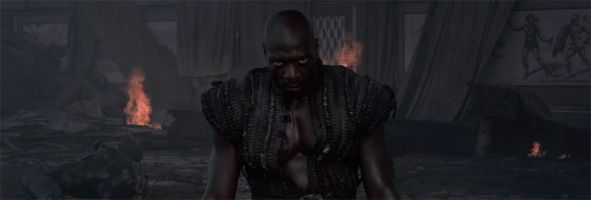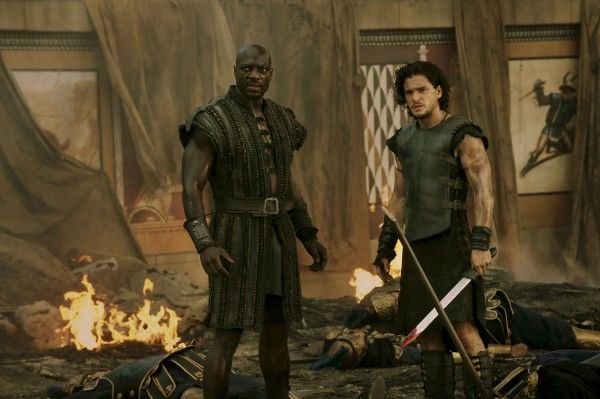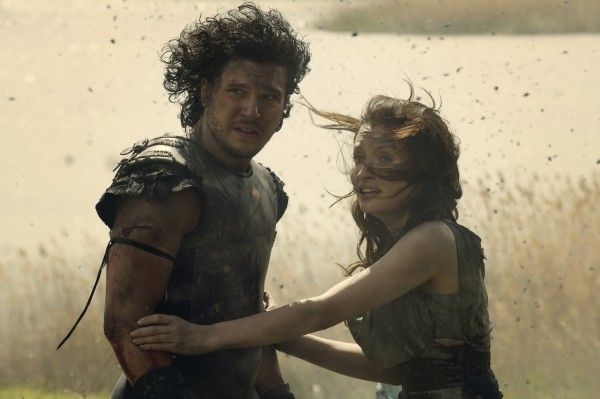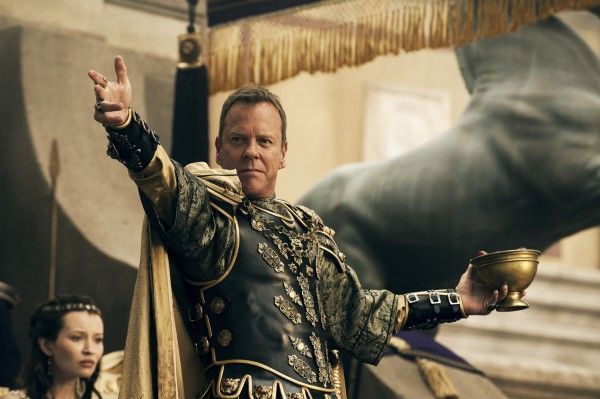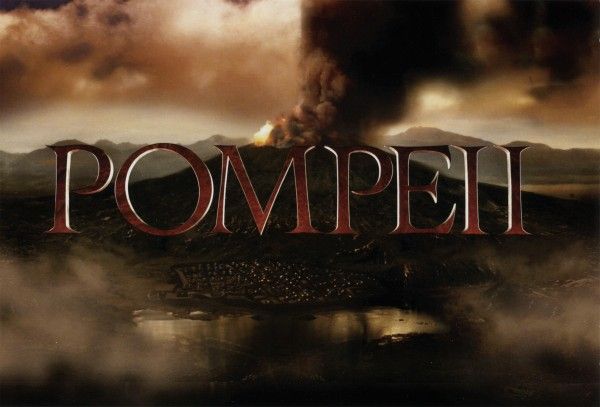While some roles are easy to prepare for, Adewale Akinnuoye-Agbaje had to work extremely hard to play a champion gladiator in director Paul W.S. Anderson's Pompeii. During a group interview on set he explained:
"It was an hour of cardio in the morning. Followed by two hours of stunt training with Jean, a great stuntman. Sword fighting, actual fighting, then I would break for lunch. Then there would be an hour of workout with weights with trainer Nino De Salas. Break for half an hour, go back for another review, then stunts for another forty-five minutes. Then you go home and do another hour’s cardio. That was the regime for four weeks. We’re given a nutritionist that gave us four meals a day and two thousand calories. That was the real challenge, doing all of that work on two thousand calories. Literally, you’re just getting up and you’re going to bed, after eight o clock you’re eating your hands."
During the rest of the interview, Akinnuoye-Agbaje talked about the intricate fight sequences, the nature of his character, being influenced by Spartacus and Ben-Hur, having a mini portable gym right beside the set, what he knew about Pompeii before being cast, and a lot more. Hit the jump for the interview.
Before going any further, if you haven't watched the Pompeii trailer, I'd watch that first:
Question: We saw you chopping down some stuff with the axe. It looks like a really physical role for you?
ADEWALE AKINNUOYE-AGBAJE: Extremely, this whole role, from the very outset, we were told it wasn’t about looking fit. You have to be fit. The director, Paul WS Anderson, wanted the actor that took the part to be able to perform the fight scenes and everything else. It was very physical, we trained for a good month to six weeks, grueling, very grueling training.
What about the regimen? What did it look like for you?
AKINNUOYE-AGBAJE: It was the gladiatorial regimen. I’ll tell you exactly. It was an hour of cardio in the morning. Followed by two hours of stunt training with Jean, a great stuntman. Sword fighting, actual fighting, then I would break for lunch. Then there would be an hour of workout with weights with trainer Nino De Salas. Break for half an hour, go back for another review, then stunts for another forty-five minutes. Then you go home and do another hour’s cardio. That was the regime for four weeks. Once I got to the set and we got into the fight sequences, it all pays off, you really need that kind of physical tuning to make this look real, and also endure. Because you’re getting cuts and bruises, you need it to get through it.
Is it hard to keep up the motivation during the training?
AKINNUOYE-AGBAJE: No, you sign on knowing. For me, it is a dream opportunity to get the part. While it was challenging, the motivation is there from the get go. We’re given a nutritionist that gave us four meals a day and two thousand calories. That was the real challenge, doing all of that work on two thousand calories. Literally, you’re just getting up and you’re going to bed, after eight o clock you’re eating your hands. The motivation was there from the onset.
How hard was it not to cheat? Two thousand calories is not a lot.
AKINNUOYE-AGBAJE: We were allowed the odd cheat day, which was a Sunday. The funny thing was, your body gets so attuned to eating pure food. Even if I wanted to gorge out, it would reject it. You would eat a couple of spoonfuls and it would hurt your stomach. In the end you just stick with it.
What are the weights? Do you use them before each take?
AKINNUOYE-AGBAJE: Yes, every take. Not only the weights, what I’ve arranged is a mini, portable gym, right beside of the set. It consists of a pull up bar, various weights, twenty, ten, fifteen pounds, push bars; which we use constantly throughout the day. It has to be consistent. You guys want the beef. This is a gladiator. You have to be pumped. So yes, all the time.
Does it help you get pumped up for the fight scenes too?
AKINNUOYE-AGBAJE: Yes, obviously, but you can’t do too much. That’s why we use light weights. Because the actual fights themselves are very demanding. You don’t want to drain yourself. But it pumps you up, gets you in the zone. It’s a good way of getting you into the zone for the scene.
Is this the first time you’ve done this for any of your roles? In terms of, in between takes, doing that kind of stuff?
AKINNUOYE-AGBAJE: No, I just completed Thor 2, which was also very physical. I did do it there, but no where near as much as this. And it’s also very important to stretch, because while it’s good to look pumped, a lot of the moves are split legs, and twisting fast. So you really, really have to stay supple. That kind of stuff I’d done before. The intensity I’ve not done before. The practice of pumping up before the scene, especially if you’ve got your shirt off, most actors will do that.
We saw you do some fight stuff earlier, what is the most complicated fight scene you have to do in the film? Is it one that has taken many days to film?
AKINNUOYE-AGBAJE: I have to be honest with you. They are all complicated, and all intricate. They’re all physically demanding. We’ve shot two of the biggest ones now. I suppose the most complicated one is from this morning, the one you saw today was not rehearsed, was not choreographed, was not scripted. It was something that was spur of the moment that worked for the dynamic of the shot. So the director will say to the stuntman, I need an action scene. You produce it on the spot and you have to get it. We had one take. That’s when it gets complicated. You have to get it right. The axe is fifteen pounds. You have to make sure you don’t hurt or hit someone. And hit the beats, because they have what, five cameras? It has to look real. That in itself becomes challenging because you have to learn it straight away. There’s no time for error. But the ones we’ve rehearsed, they kind of flow. The challenging thing obviously is to do it many times, because they want to get it from different angles. Also, when you train, obviously in a gym setting, the choreography in these fights, when you get on the set, the camera angles dictate how the fight is going to go. So it’s completely different. One of the fights I have with Milo, Kit Harington, is a brilliant fight. You’re going to love it. It was really complicated because I had to stand by the camera. And the camera pulls back as he charges, but they didn’t want me to actually move. So you have to do all the moves, but in a very restricted area; which is completely different from what you’ve learned. But it works for the camera, so you have to be very conscious that whatever you’ve learned can be twisted, chopped. You have to be on it.
Can you talk about your character? Who do you play? What’s your part in the story?
AKINNUOYE-AGBAJE: I can. I play a character by the name of Atticus. Atticus is obviously a slave gladiator. He’s the champion gladiator of Pompeii. When doing the research, I looked to see how an African could end up in an Italian, gladiatorial ring. Back in those days, obviously, Italy was colonializing and exploring. And it used to actually join with Africa, some parts of Italy. So the northern part, The Moors, Mauritania, would go around on ships. They were very skilled salesmen, tradesmen, and quite intelligent. So it’s feasible these people would have been captured in battles and then brought to Pompeii. Based on that, I played Atticus with a certain amount of dignity, honor, because he came from a rich tradition. But his storyline, his whole reason for living, is freedom. He has one more fight. Within Roman law, if you reach a certain quota of deaths, you can earn your freedom. As a champion gladiator, he has reached all but one fight. But that fight he has to have, is the man he’s rooming with, Kit Harington. It’s a really interesting dynamic between them. They share a room. They know they are going to kill each other the next day. I’m not going to lose because I’m going to be a free man.
What’s interesting about the character, it’s such a beautiful character, it has so many layers. He’s humorous, despite of the circumstances. He’s prayerful, I don’t think any of the other gladiators have shown that. He has faith and that’s probably what gets him through. He prays before he goes to the ring. And I suppose the other thing, which you saw today, is that he’s absolutely fearless and vicious when he gets out there. I liked the differences in his character. In his cell, he’s very calm, very matter of fact, and quite charming. But when he gets out there, you saw the axe, it’s as big as me. He’s chopping people in pieces and has no mercy. He’ll do the same to Kit Harington because he wants his freedom. That’s who he is really. And through their relationship, sharing within the same bunk, fighting together, they develop a respect for each other. And a deep friendship, which is really powerful, you know they have to kill each other. I won’t say any more or I’ll give away the whole story. With that kind of drama, it just makes it such a rich character. No matter your gender, you just don’t characters in this genre that are so complex and rich. You know what I mean? It’s a great opportunity.
What’s interesting about this genre is that there have been good, fascinating roles for black actors. Woody Strode in Spartacus, Djimon Hounsou in Gladiator, did you take any cues from those guys?
AKINNUOYE-AGBAJE: No, obviously I grew up watching the epics. Ben-Hur, Spartacus, if I took any cues it would have been those. I think always as an actor. I go in knowing how I’m going to play it. That’s about it. There’s a temptation to pick up the dirt and rub it. (laughs) You have to be as far away from that as possible. I think because of those films that have gone before, I choose not to watch them. Because you don’t want it to be a replica or an imitation. You want to create something fresh, original, very unique. So I kind of stayed away from looking at any of that stuff. But knowing, in the back of my mind, I just had this epic image of Ben-Hur and Spartacus. Because they are the Holy Grail as far as these movies go. The scope was always there. And then you come out to the setting, and you just feel it, and you have an audience as well. I was Charlton Heston, in body, is someone I would have looked to. That’s the scope of Atticus. He’s a hero of that vastness. In the back of my mind I may have related to that, but at the end of the day, it was always about connecting with the heart of the character, and making him unique, making him real.
Besides Milo, do you have any interaction with the other characters? Does he have an axe to grind with anyone else?
AKINNUOYE-AGBAJE: Oh yes, that’s a very good pun as well, axe to grind. There’s an African gladiator whose housed next door to me. And because of the culture, even though we don’t speak the same language, which is interesting because we’re not from the same tribe or country. But we connect, we kind of have each others back, certainly in the ring, more so any other gladiator. When he’s out there and there’s a demise, it’s a big moment, you’ll see that in the movie. So there is the African gladiator, and then there is Bellator, the prison keeper. He just so enjoys his job. But there’s a lot of envy of him by me, because he used to be a gladiator but he won his freedom. But he never got the respect, the fame, the notoriety that I have achieved in the ring. And I’m always giving that to him. He’s always sticking it to me. He knows in my next fight, I’m a free man. I’ll take his job, or whatever. There’s a real rivalry, envy, and jealousy between them. They are always going at it. And he’s always trying to set him up against the most impossible situation or fight, so that he doesn’t make it. But he always comes out. It’s a really nice, juicy feud they have. What you find interesting is that Atticus is always very cool and laid about it. He just chides him and laughs because he knows he’s going to win. Whether he does or not, you’ll have to see, but it is a nice relationship between jailer and prisoner. What you’ll see is who is the real prisoner, and who is the real jailer, Atticus is quite free, even though he’s behind the bar. The jailer is really angry because each time we win a fight, you get your little treats, you get women, fruit, and food. There’s a scene where you see that. And he’s very pissed off. He’s not enjoying that.
Did you know much about Pomeii before this role? And what did you discover about it that really sticks out?
AKINNUOYE-AGBAJE: I’m from Europe, England, and I actually lived in Italy. I was aware of it. I didn’t really know a lot about it. I knew it was historical fact. I knew it had occurred. But I remember coming into the film, Paul Anderson, the director, and Jeremy Bolt, they sent all of the cast this really great book. It was a large, thick book on Pompeii. I kind of read it before I started. The thing that stuck out was that in the first couple of pages, you see the relics of these human beings, that are encased, enshrined in molten lava. It’s real, horses in movement, people embraced, children, all captured in motion. Enshrined in this lava. I thought, wow, we’re not just making a movie, this was real. And the movie starts from that premise, and takes you back through how they came to be enshrined at this particular spot in Pompeii. That was a brilliant way to start the movie, it’s not only entertaining, but educational. I felt for the people. You can see the agony in their contorted bodies as they are being burned alive. And also I saw the structure, and how beautiful Pompeii was before. The most striking thing is the agony, it really informs you the performer, this was real, they really died. And this is where we’re headed. When you see a woman with her baby, hanging off her arm, unbelievable. It must have happened like that. When you’re doing something that’s real. It just makes the part juicier.
Check out some of my other coverage from the set visit:
- 5 Major Takeaways and 65 Things to Know About Director Paul W.S. Anderson's POMPEII From Our Set Visit
- Kit Harington Talks Bulking Up for the Role, His Love of Action, the Popularity of GAME OF THRONES, and More on the Set of POMPEII
- Kiefer Sutherland Talks Playing the Bad Guy, the Production Value, Looking Back on His Career, the Return of 24, and More on the Set of POMPEII
- Director Paul W.S. Anderson Talks Building Practical Sets, Expanding into Love Story Territory, and More on the Set of POMPEII
- Producer Jeremy Bolt Talks Shooting in Canada, Drone Cameras, How Much of the Film Is Factual, 3D, and More on the Set of POMPEII

